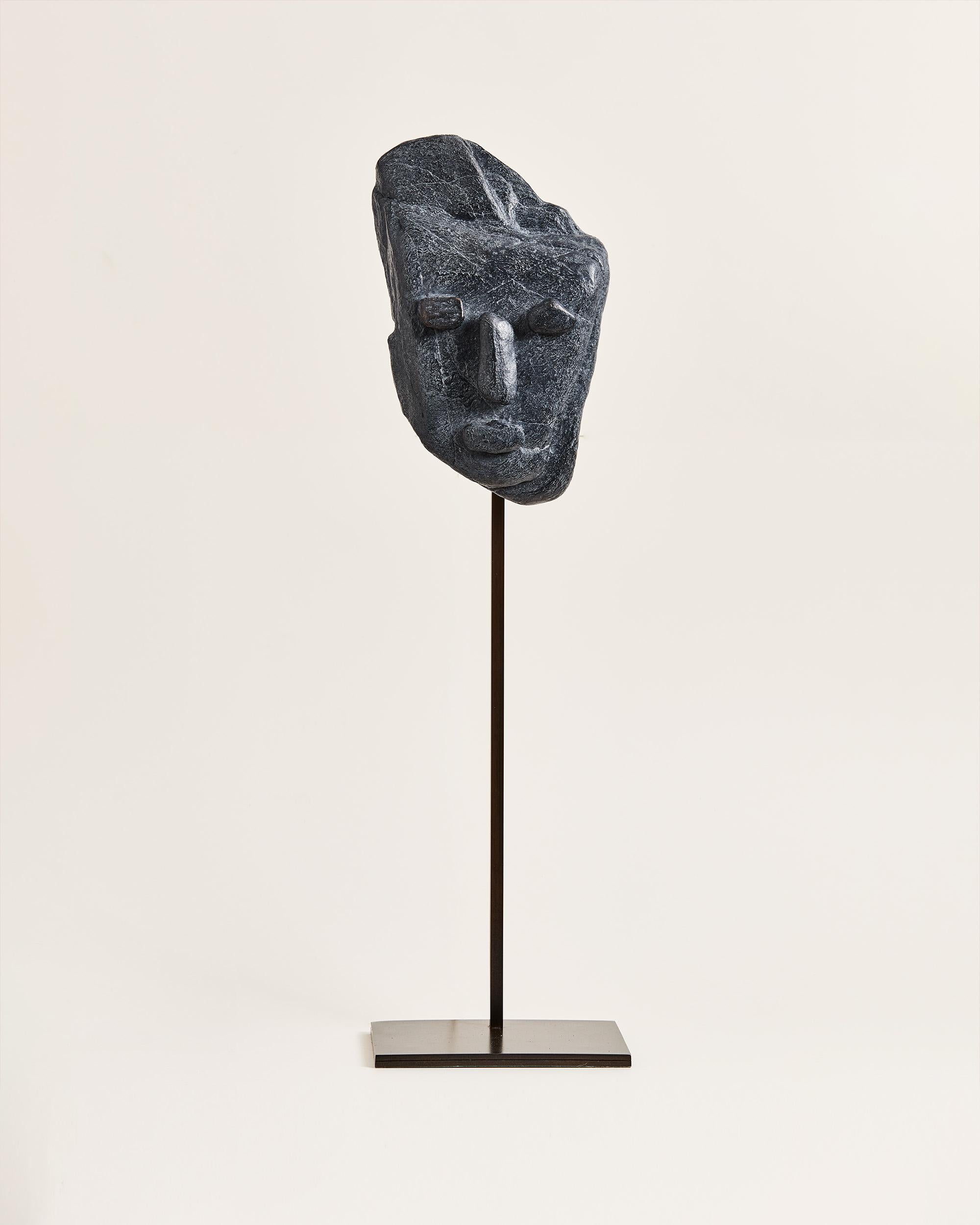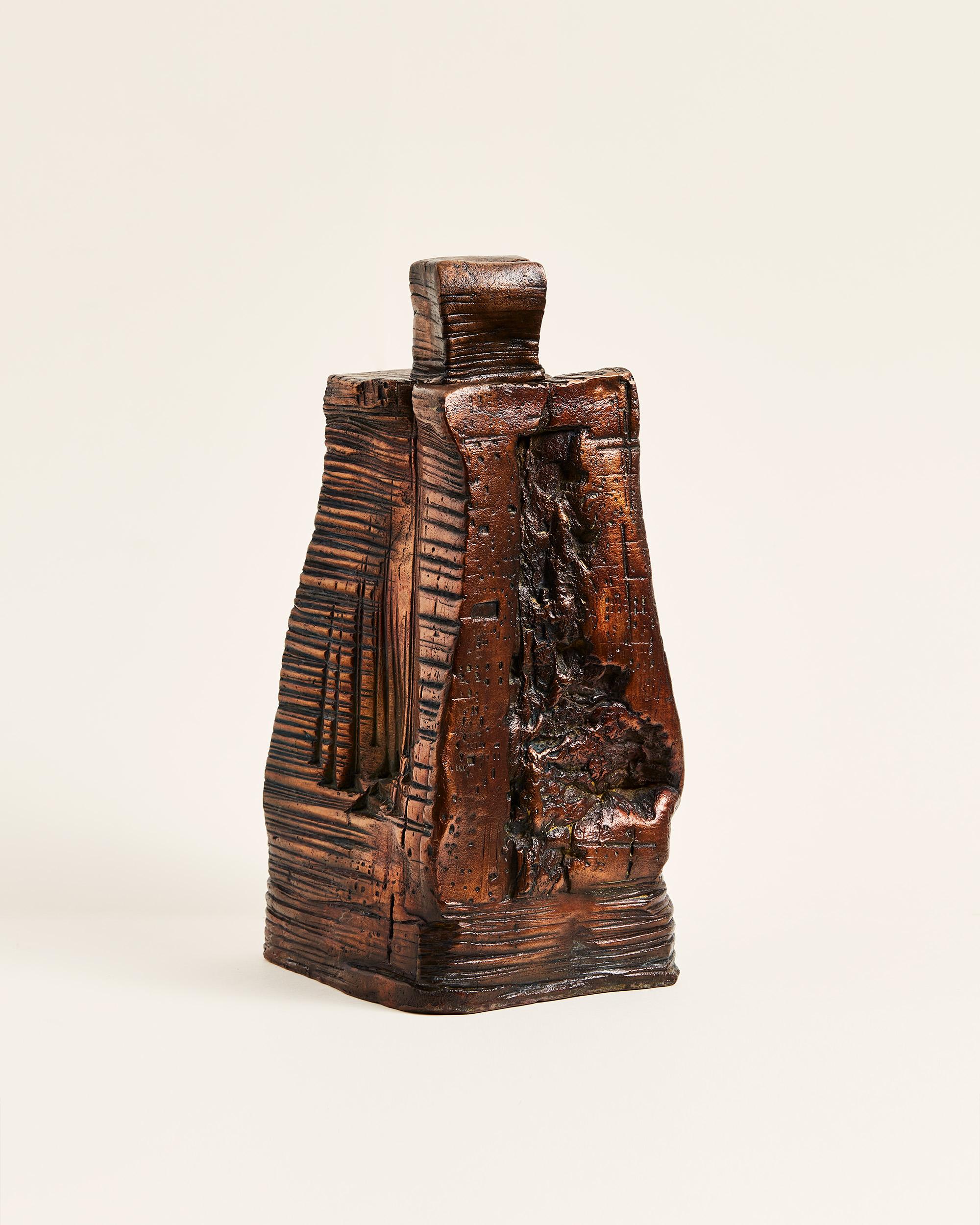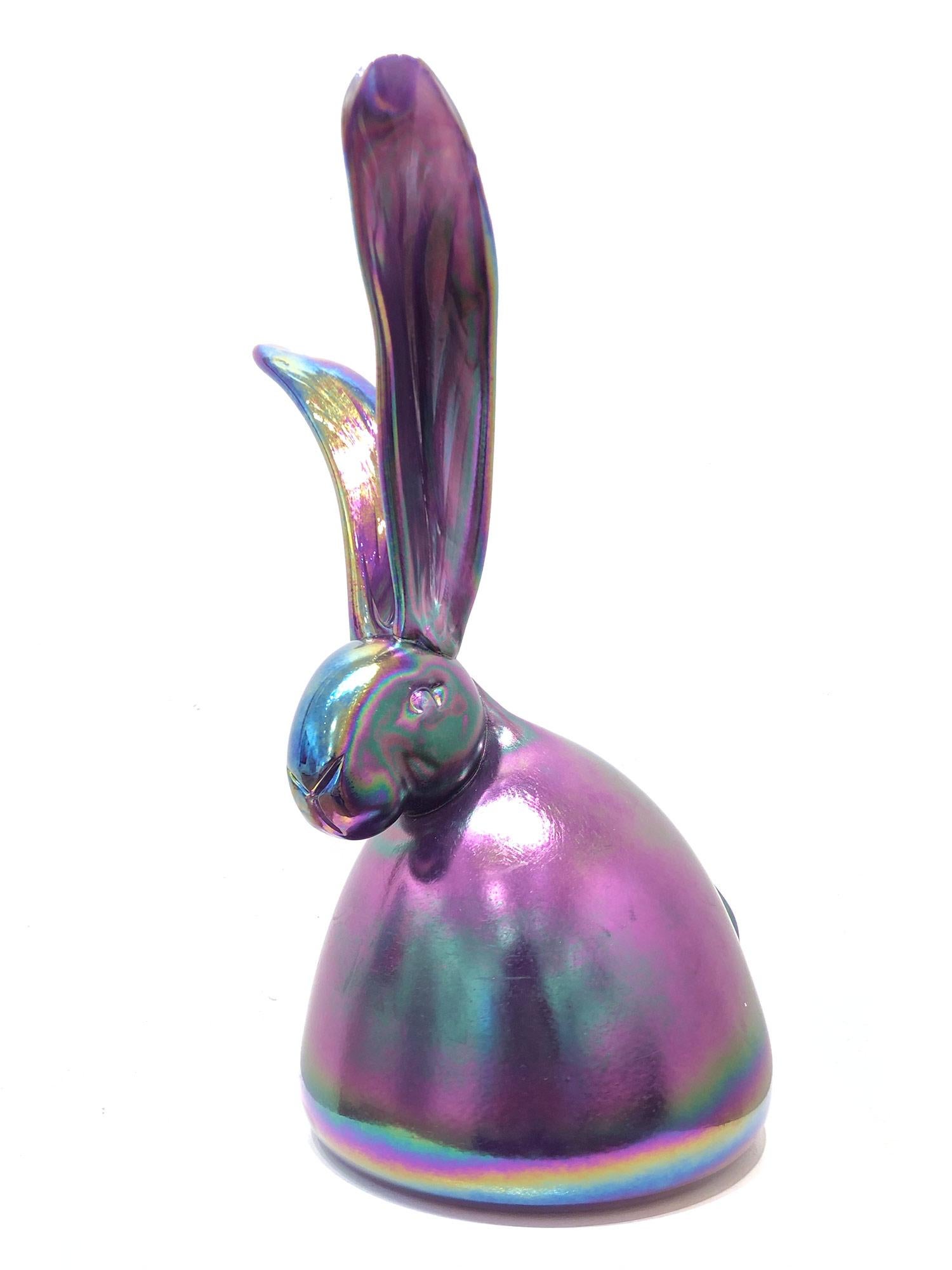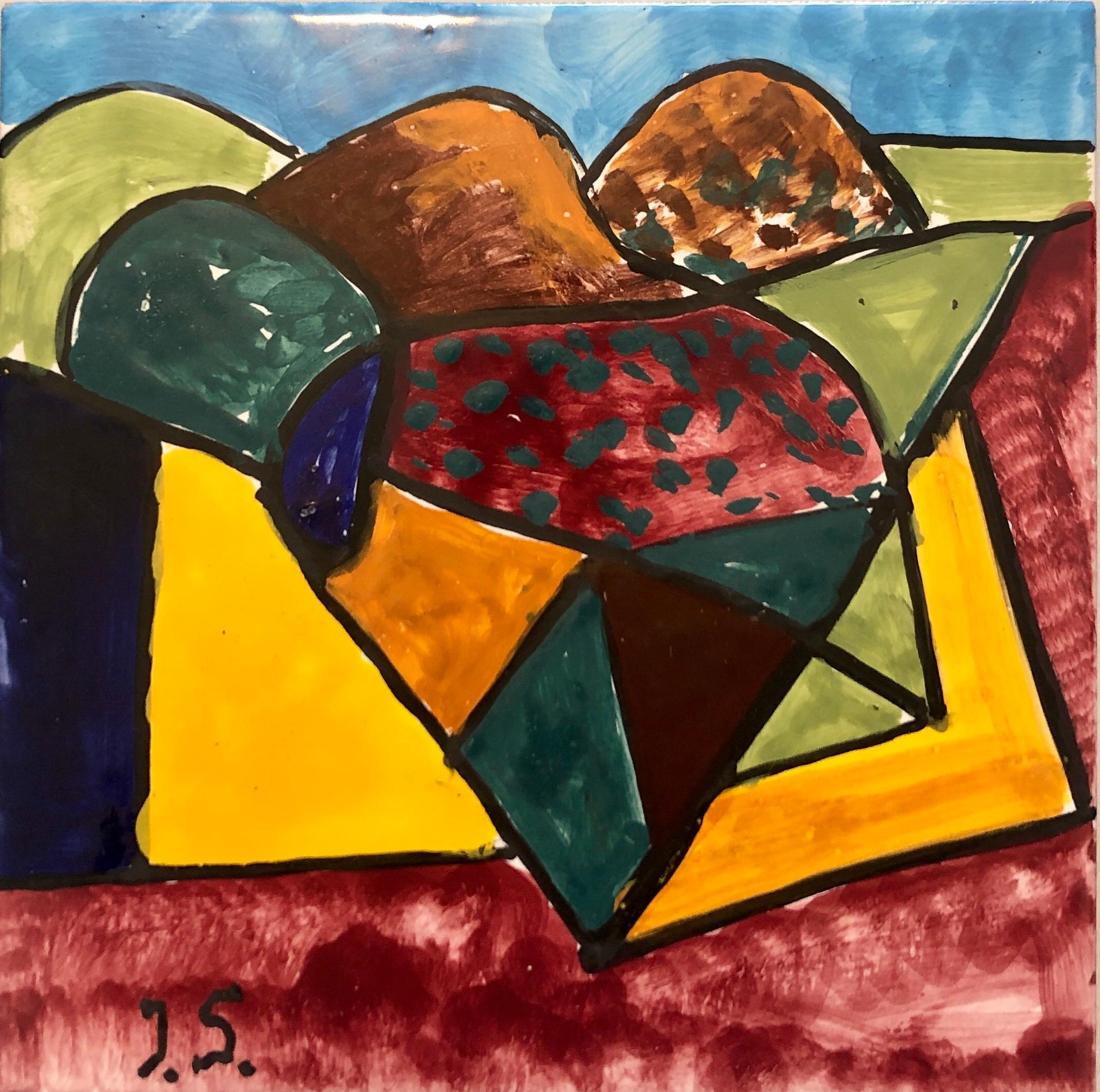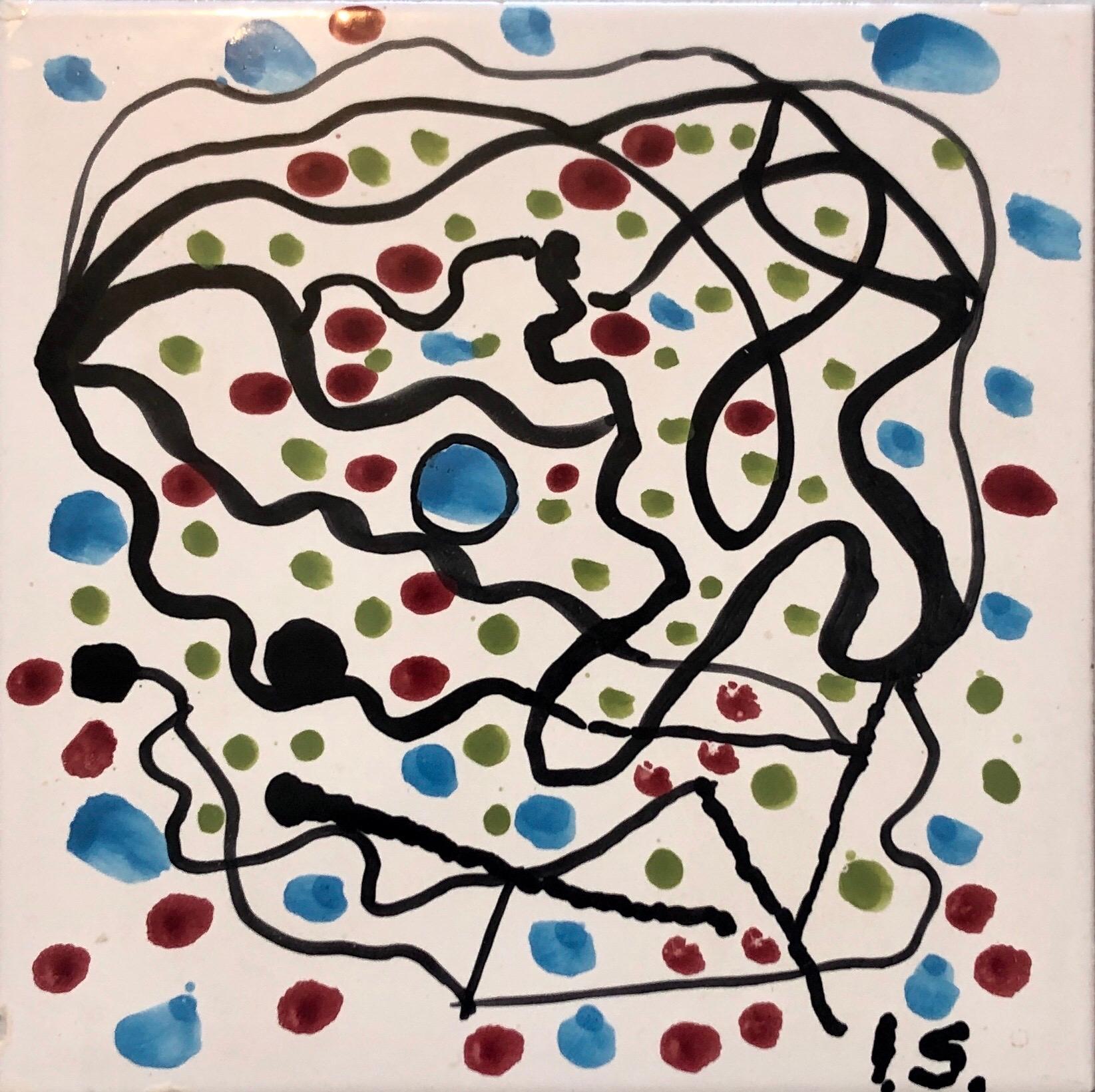Items Similar to Abstract Sculpture 'Ten Fathoms' (Swimming Fish) Bronze with Glass Unique Piece
Want more images or videos?
Request additional images or videos from the seller
1 of 7
Margaret Peggy ReventlowAbstract Sculpture 'Ten Fathoms' (Swimming Fish) Bronze with Glass Unique Piece
About the Item
Margaret Reventlow, American born London, 1915 - 2014, "Ten Fathoms Deep", (swimming fish) bronze with green and red slag glass, unsigned, with artist name, title, etc on a label on its swivel base.
Provenance: From the Estate of Countess Margaret Peggy Reventlow, Philanthropist and Artist, Direct Descendent of John Jacob Astor, then to the Oliver Wolcott Library. Reventlow's first exhibition was at the Palm Beach Gallery and she went on to shows in New York, London, Connecticut and Nantucket.
MARGARET PEGGY REVENTLOW (Margaret Astor Drayton)
American, 1915-2014
Peggy was born in London, England on December 20th, 1915. Her father, William Astor Drayton, was a great grandson of John Jacob Astor. In 1942, Peggy became Countess Margaret Reventlow when she married Danish Count Court Haugwitz-Hardenberg Reventlow.
Rentlow studied at Le Cours Maintnon in Paris and at Le College Feminin de Bouffemont. She studied sculpture with Oliver Barret and Felix de Weldon. She attended the Art Students League for six years, studying with Leo Manso and Bruce Dorfman. The resulting abstract paintings are rich and colorful, done in both acrylics and oils. “My paintings are all about movement and color and composition,” she said. “You have to work that way with abstract art.
Reventlow’s first solo New York exhibition took place at Hammer Galleries in 1961 and she exhibited there until 1968. In 1964 she had a solo exhibition at Tiffany and Co. Her work has been presented at the Palm Beach Galleries and at The Alwin Gallery in London as well as in Litchfield, Connecticut; Nantucket; Norfolk, Connecticut and elsewhere.
Her sculptures and paintings reflect her lifelong love of the outdoors and sports. Writing in Arts Magazine, critic William D. Allen remarked on the vibrant character of her work which he compared to that of the noted German Expressionist sculptors Ernst Barlach and Wilhelm Lehmbruck. Countess Reventlow was represented in New York by Viridian Artists.
- Creator:Margaret Peggy Reventlow (1915 - 2014, American)
- Dimensions:Height: 18 in (45.72 cm)Width: 15 in (38.1 cm)Depth: 14 in (35.56 cm)
- Medium:
- Movement & Style:
- Period:
- Condition:slag glass with natural defects and inclusions, bronze and glass are good.
- Gallery Location:Surfside, FL
- Reference Number:1stDibs: LU38212162112
About the Seller
4.9
Platinum Seller
These expertly vetted sellers are 1stDibs' most experienced sellers and are rated highest by our customers.
Established in 1995
1stDibs seller since 2014
1,568 sales on 1stDibs
Typical response time: 1 hour
- ShippingRetrieving quote...Ships From: Surfside, FL
- Return PolicyA return for this item may be initiated within 3 days of delivery.
More From This SellerView All
- Abstract Painted Ceramic Tile Pop Art Painting Italian Neo Figurative PaintingBy Italo ScangaLocated in Surfside, FLThis painted ceramic tile by Italo Scanga, epitomizes the characteristics of his oeuvre. Polychrome and vibrant art from the Memphis Milano era. This is signed with his initials. This is reminiscent of the mid century work of Jean Lurcat and Jean Picart le Doux. Italo Scanga (June 6, 1932 - July 7, 2001), an Italian-born American artist, was known for his sculptures, prints and, paintings, mostly created from found objects. In his youth in Calabria, Italy he worked as a cabinetmaker's apprentice and studies sculpture with a man who carved statues of saints. Italo Scanga was an innovative neo Dada, neo-Expressionist, and neo-Cubist multimedia artist who made assemblage, collage, sculptures of ordinary objects and created prints, glass, and ceramic works. Modern Italian abstract geometric folk art. Scanga's materials included natural objects like branches and seashells, as well as kitsch figurines, castoff musical instruments and decorative trinkets salvaged from flea markets and thrift shops. He combined these ingredients into free-standing assemblages, which he then painted. Although visually ebullient, the results sometimes referred to gruesome episodes from Greek mythology or the lives and deaths of martyred saints. He considered his artistic influences to be sweepingly pan-cultural, from African sculpture to Giorgio de Chirico. He often collaborated with the sculptor Dale Chihuly, who was a close friend. Constructed of wood and glass, found objects or fabric, his ensembles reflect a trio of activities—working, eating, and praying. These activities dominate the lives of those who live close to the land, but they are also activities that are idealized by many who contemplate, romantically, a simpler, bucolic life. Italo graduated from Michigan State University where he befriended fellow artists Richard Merkin and David Pease. He studied under Lindsey Decker who introduces him to welding and sculpture after his initial interest in photography. Also studies with Charles Pollock, the brother of Abstract Expressionist Jackson Pollock. His first teaching job was at University of Wisconsin (through 1964). where he met Harvey Littleton, a fellow instructor. He later moves to Providence, Rhode Island,I to teach at Rhode Island School of Design (RISD). Is colleagues with artists Richard Merkin and Hardu Keck. Starts a correspondence with HC Westermann. Spends summers teaching at Brown University; colleague of Hugh Townley. Moves to State College, PA, and teaches at Pennsylvania State University for one year. Meets artists Juris Ubans, Harry Anderson, Richard Frankel, and Richard Calabro, who remain friends throughout his career. 1967: David Pease helps him get a tenure track position at Tyler School of Art in Philadelphia, PA, . Artists he works closely with include Ernest Silva, Lee Jaffe, Donald Gill, and William Schwedler. Meets graduate student Dale Chihuly while lecturing at RISD and develops a lifelong friendship. 1969: One person exhibition, Baylor Art Gallery, Baylor University, Waco, TX. Works very closely with students Larry Becker and Heidi Nivling (who later run a gallery in Philadelphia, PA), and Harry Anderson. Welcomes many artists into his home including Donald Judd, Dan Flavin, Bruce Nauman (a former student), Vito Acconci, Ree Morton and Rafael Ferrer. 1973: "Saints Glass" at 112 Greene Street Gallery, NYC. Installation at the Institute of Contemporary Art at University of Pennsylvania, Philadelphia, PA. Meets Gordon Matta Clark and contributes to an artist cookbook. Goes to Pilchuck Glass School, Stanwood, WA, founded by Dale Chihuly, as a visiting artist. He continues to work there annually through 2001. Works over the years with Pilchuck artists Richard Royal, Seaver Leslie, Jamie Carpenter, Joey Kirkpatrick, Flora Mace, Robbie Miller, Billy Morris, Buster Simpson, Toots Zynsky, Howard Ben Tre...Category
1980s Neo-Expressionist Abstract Sculptures
MaterialsEnamel
- Abstract Painted Ceramic Tile Pop Art Painting Italian Neo Figurative PaintingBy Italo ScangaLocated in Surfside, FLThis painted ceramic tile by Italo Scanga, epitomizes the characteristics of his oeuvre. Polychrome and vibrant art from the Memphis Milano era. This is signed with his initials. This is reminiscent of the mid century work of Jean Lurcat and Jean Picart le Doux. Italo Scanga (June 6, 1932 - July 7, 2001), an Italian-born American artist, was known for his sculptures, prints and, paintings, mostly created from found objects. In his youth in Calabria, Italy he worked as a cabinetmaker's apprentice and studies sculpture with a man who carved statues of saints. Italo Scanga was an innovative neo Dada, neo-Expressionist, and neo-Cubist multimedia artist who made assemblage, collage, sculptures of ordinary objects and created prints, glass, and ceramic works. Modern Italian abstract geometric folk art. Scanga's materials included natural objects like branches and seashells, as well as kitsch figurines, castoff musical instruments and decorative trinkets salvaged from flea markets and thrift shops. He combined these ingredients into free-standing assemblages, which he then painted. Although visually ebullient, the results sometimes referred to gruesome episodes from Greek mythology or the lives and deaths of martyred saints. He considered his artistic influences to be sweepingly pan-cultural, from African sculpture to Giorgio de Chirico. He often collaborated with the sculptor Dale Chihuly, who was a close friend. Constructed of wood and glass, found objects or fabric, his ensembles reflect a trio of activities—working, eating, and praying. These activities dominate the lives of those who live close to the land, but they are also activities that are idealized by many who contemplate, romantically, a simpler, bucolic life. Italo graduated from Michigan State University where he befriended fellow artists Richard Merkin and David Pease. He studied under Lindsey Decker who introduces him to welding and sculpture after his initial interest in photography. Also studies with Charles Pollock, the brother of Abstract Expressionist Jackson Pollock. His first teaching job was at University of Wisconsin (through 1964). where he met Harvey Littleton, a fellow instructor. He later moves to Providence, Rhode Island,I to teach at Rhode Island School of Design (RISD). Is colleagues with artists Richard Merkin and Hardu Keck. Starts a correspondence with HC Westermann. Spends summers teaching at Brown University; colleague of Hugh Townley. Moves to State College, PA, and teaches at Pennsylvania State University for one year. Meets artists Juris Ubans, Harry Anderson, Richard Frankel, and Richard Calabro, who remain friends throughout his career. 1967: David Pease helps him get a tenure track position at Tyler School of Art in Philadelphia, PA, . Artists he works closely with include Ernest Silva, Lee Jaffe, Donald Gill, and William Schwedler. Meets graduate student Dale Chihuly while lecturing at RISD and develops a lifelong friendship. 1969: One person exhibition, Baylor Art Gallery, Baylor University, Waco, TX. Works very closely with students Larry Becker and Heidi Nivling (who later run a gallery in Philadelphia, PA), and Harry Anderson. Welcomes many artists into his home including Donald Judd, Dan Flavin, Bruce Nauman (a former student), Vito Acconci, Ree Morton and Rafael Ferrer. 1973: "Saints Glass" at 112 Greene Street Gallery, NYC. Installation at the Institute of Contemporary Art at University of Pennsylvania, Philadelphia, PA. Meets Gordon Matta Clark and contributes to an artist cookbook. Goes to Pilchuck Glass School, Stanwood, WA, founded by Dale Chihuly, as a visiting artist. He continues to work there annually through 2001. Works over the years with Pilchuck artists Richard Royal, Seaver Leslie, Jamie Carpenter, Joey Kirkpatrick, Flora Mace, Robbie Miller, Billy Morris, Buster Simpson, Toots Zynsky, Howard Ben Tre...Category
1980s Neo-Expressionist Abstract Sculptures
MaterialsEnamel
- Early Murano Glass Free Form Abstract Blown, Cut, Glass Sculpture in Bronze VaseLocated in Surfside, FLThis piece appears unsigned and unmarked. It came from an important estate in the Palm Beach area. It is an abstract flame or torch in a bronze vase. Venetian glass (Italian: vetro ...Category
1940s Abstract Abstract Sculptures
MaterialsBronze
- Two Figures (Art Brut Bronze Sculpture)By Aharon BezalelLocated in Surfside, FLAharon Bezalel (born Afghanistan 1926) Born in Afghanistan in 1926 and immigrated to Israel at an early age. As a youth was engaged as a silversmith and craftsman, and was a student of the sculptor Zev Ben-Zvi from whom he absorbed the basic concepts of classic and modernist art and interpreted, according to them, ideas based on ancient Hebrew sources. Aharon Bezalel works and resides in Jerusalem, he taught art for many years. “I saw myself as part of this region. I wanted to find the contact between my art and my surroundings. Those were the first years of Jean Piro’s excavations at the Beer-Sheba mound. They found there, for example, the Canaanite figurines that I especially liked and that were an element that connected me with the past and with this place.” “…a seed and sperm or male and female. These continue life. The singular, the individual alone, cannot exist; I learned this from my father who dabbled with the Kabbalah.” (Aharon Bezalel, excerpt from an interview with David Gerstein) “The singular in Aharon Bezalel’s work is always potentially a couple if not a threesome[…] the one is also the many: when the individual is revealed within the group he will always seek a huddling, a clinging together. The principle of modular construction is required by this perception of unity and multiplicity, as modular construction in his work is an act of conception or defense. Two poles of unity, potentially alone, exist in A. Bezalel’s world: From a formal, sculptural sense these are the sphere and pillar, metaphorically these are the female in the final stages of pregnancy and the solitary male individual. Sphere-seed-woman; Pillar-strand-man. The disproportional, small heads in A. Bezalel’s figures leave humankind in it’s primal physical capacity. The woman as a pregnancy or hips, the man as an aggressive or defensive force, the elongated chest serves as a phallus and weapon simultaneously. (Gideon Ofrat) EIN HAROD About the Museum's Holdings: Israeli art is represented by the works of Reuven Rubin, Zaritzky, Nahum Gutman...Category
1960s Expressionist Abstract Sculptures
MaterialsBronze
- Girl Seated a la Japonaise Bronze Sculpture Morris Singer Foundry.By Helaine BlumenfeldLocated in Surfside, FLGirl Seated a la Japonaise, 1964, polished bronze. It was exhibited at The Chapman Gallery NYC in 1968. Cast at Morris Singer Foundry and numbered 4/6 signed with the artists monogram. Helaine Blumenfeld OBE (born, New York 1942) is an American Sculptor working in Britain and Italy, best known as an artist who has pioneered new methods of carving in stone and for her semi-abstract marble, granite and bronze sculptures which are located around the world as Public art. Her forms are often abstractions of human forms and of elements in nature. She is widely recognized as the most significant sculptor of her generation and "the heir apparent to HenryMoore and Barbara Hepworth." In 1973, Blumenfeld, who had recently moved to England, exhibited at Kettle's Yard in Cambridge England. These early sculptures, which were mostly cast in bronze were largely figurative work in the tradition of sculptors such as Constantin Brâncuși, Jacob Epstein, Jean Arp, Henri Gaudier-Brzeska, Henry Moore and of course her one time teacher Ossip Zadkine. In 1985, the Alex Rosenberg Gallery in New York showed her sculpture in dialogue with Henry Moore In 1978, Blumenfeld's first visit to Pietrasanta in Italy marked a turning point in her work as she started carving in marble, mostly at Studio Sem, founded in the 1950s by Sem Ghelardini (1927-1997) who gained international notoriety producing the large scale works of Henry Moore, César Baldaccini, Emile Gilioli, Joan Mirò, Georges Adam and many other celebrated sculptors during the first wave of modern abstract sculpture in the 1960s. Throughout the 1980s and 1990s Blumenfeld's sculpture, now less clearly figurative but still often of portraying couples and family units in multiple configurations, was exhibited at the Bonino Gallery in New York and in solo and group shows around the world. A member of the Visual Arts Panel of the Arts Council of Great Britain between 1981 and 1988, Blumenfeld was elected a member of the Royal British Society of Sculptors in 1993. Blumenfeld has created over 80 large scale sculptures in bronze, granite, marble and steel in Europe and the United States for private and public clients, including the British Petroleum headquarters in London, the Lincoln Center in New York the Cass Sculpture Foundation at Goodwood and Family (Blumenfeld) at the Henry Reuss Plaza in Milwaukee and The Lancasters at Lancaster Gate in London. At Cambridge University, her sculpture has been commissioned by Clare Hall (Flame, 2004) and Newnham College...Category
1960s Abstract Sculptures
MaterialsBronze
- Brutalist Bronze Abstract Modernist SculptureLocated in Surfside, FLIn the manner of Julio Gonzalez, mixed metal sculpture. Neo-Dada Abstract Sculpture: Assemblages Abstract sculpture followed a slightly different course. Rather than focusing on non-figurative subject matter, it concentrated on materials, hence the emergence of Assemblage Art - a form of three-dimensional visual art made from everyday objects, said to be 'found' by the artist (objets trouves). Popular in the 1950s and 1960s in America, assemblage effectively bridged the gap between collage and sculpture, while its use of non-art materials - a feature of Neo-Dada art - anticipated the use of mass-produced objects in Pop-Art. Assemblage sculpture is exemplified by the works of Louise Nevelson (1899-1988), such as Mirror Image 1 (1969, Museum of Fine Arts, Houston), and by Jean Dubuffet (1901-85) and his Monument with Standing Beast (1960, James R. Thompson Center, Chicago). The idiom was considerably boosted by an important exhibition - "The Art of Assemblage" - at the Museum of Modern Art, in New York, in 1961. Other examples of the Neo-Dadaist-style "junk art...Category
20th Century Abstract Expressionist Abstract Sculptures
MaterialsBronze, Copper
You May Also Like
- Boite empreinte - Contemporary Bronze abstract Sculpture, 2015Located in PARIS, FRSculpture en bronze de l'artiste Pascale Hamelin. Pascale Hamelin est une sculptrice française. Ses visages et ses formes racontent le souvenir du pass...Category
2010s Neo-Expressionist Abstract Sculptures
MaterialsBronze
- Bronze Grand Bénatien - Contemporary Bronze Portrait Sculpture, 2015Located in PARIS, FRSculpture en bronze sur socle par l'artiste Pascale Hamelin. Pascale Hamelin est une sculptrice française. Ses visages et ses formes racontent le souv...Category
21st Century and Contemporary Neo-Expressionist Abstract Sculptures
MaterialsBronze
- Boite empreinte - Contemporary Bronze abstract SculptureLocated in PARIS, FRSculpture en bronze de l'artiste Pascale Hamelin. Pascale Hamelin est une sculptrice française. Ses visages et ses formes racontent le souvenir du pas...Category
2010s Neo-Expressionist Abstract Sculptures
MaterialsBronze
- "Zofia" Unique Glass Blown Bunny Sculpture in an Iridescent Purple ColorBy Hunt SlonemLocated in New York, NYEver expansive in his Animalia quest, renowned artist Hunt Slonem continues to boldly pursue his unique vision. Divining new forms for his aesthetic muses in hand-blown glass, neon and other illuminating raw materials, the artist’s impressive career spanning almost five decades enters a new phase. Bunnies. This piece depicts a gestural figure of purple iridescent bunny. This is a one of a kind piece. Illuminating and awe inspiring, Hunts new Glass Blown Sculptures...Category
2010s Neo-Expressionist Figurative Sculptures
MaterialsGlass
- "Il narratore" by Enzio Wenk, 2020 - Pink Wooden Sculpture, Neo-ExpressionismBy Enzio WenkLocated in Bresso, ITTranslated title: "The narrator". Enamel, wood, charcoal and gauze.Category
2010s Neo-Expressionist Abstract Sculptures
MaterialsEnamel
- Standing FigureLocated in Wilton Manors, FLTom Cramer (b.1960). Standing Figure, 1980. Carved wood and polymer paint. Measures 11.5 inches high. Excellent condition. Signed and dated under base. Tom Cramer is an American artist working in Portland, Oregon noted for his intricately carved and painted wood reliefs and ubiquity throughout the city of Portland. Often called the unofficial Artist Laureate of Portland,[2] Cramer is one of the most visible and successful artists in the city. The influences on his work are both organic and technological. He is widely collected and is in many prominent west coast museum and private collections. He is in the permanent collections of the Portland Art Museum[3] in Portland Oregon, the Halle Ford Museum in Salem Oregon, the Jordan Schnitzer Museum in Eugene, Oregon, the Boise Art Museum in Idaho. Cramer made a name for himself in the 1980s and 1990s becoming a bridge between historical Oregon artists like Clifford Gleason and Milton Wilson...Category
Late 20th Century Neo-Expressionist Figurative Sculptures
MaterialsWood, Latex
Recently Viewed
View AllMore Ways To Browse
Glass And Bronze Sculpture
Red Art Glass Sculpture
Unsigned Art Glass
Abstract Bronze Sculpture On Base
Abstract Danish Sculpture
Bronze Fish
Glass Fish Sculpture
Glass Sculpture Colorful
Bronze Sculpture Denmark
Bronze Fish Sculpture
Tiffany Le
Unique Art Glass Co
Gold Fish Sculpture
Swimming Sculpture
20th Century Nantucket
William Oliver
Hammered Bronze Sculpture
Leo Glass

